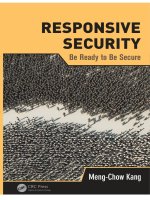Hacking ebook wallingouttheinsiders
Bạn đang xem bản rút gọn của tài liệu. Xem và tải ngay bản đầy đủ của tài liệu tại đây (3.41 MB, 373 trang )
It is often assumed that IT viruses and hackers should be an organization’s biggest
concern. The reality is that it is your own staff, whether maliciously or accidentally,
that are the most common cause of a security breach. Research continually shows
the greatest volume of security breaches comes from ignorant or careless user
actions that inadvertently cause security breaches.
Walling Out the Insiders is grounded in the reality that many, if not most organizations, have limited security budgets and security personnel.
Walling Out the Insiders
• Explains security planning and management strategies in a manner that
can be understood by security professionals as well as non-security
managers and executives
• Provides long-term security design, implementation, and management
methods to guide managers through the long process of achieving
improved security
• Presents practical advice on how to determine security weaknesses and
security needs and how to select security vendors and service providers
Walling Out the Insiders provides a self-assessment method for the state of
security in an organization along with several other self-assessment lists. These
straight-forward and easy-to-use assessment tools and self-assessment questions
will help you determine the perception of security and to determine how well key
employees think your organization is managing security.
an informa business
www.crcpress.com
6000 Broken Sound Parkway, NW
Suite 300, Boca Raton, FL 33487
711 Third Avenue
New York, NY 10017
2 Park Square, Milton Park
Abingdon, Oxon OX14 4RN, UK
K30638
ISBN: 978-1-138-03160-9
90000
9 781138 031609
w w w.crcp re s s .co m
Walling Out the Insiders
Controlling Access to Improve
Organizational Security
Walling Out the Insiders
Today’s reality is that there are proactive steps to mitigate the risks from both
malicious and careless users. Above all, Walling Out the Insiders: Controlling
Access to Improve Organizational Security is practical. It will assist you in taking
action to improve your organization’s security policies and procedures as well as to
implement a wide range of appropriate security measures.
Erbschloe
Information Technology
Michael Erbschloe
Walling Out the Insiders
Controlling Access to Improve
Organizational Security
Walling Out the Insiders
Controlling Access to Improve
Organizational Security
Michael Erbschloe
CRC Press
Taylor & Francis Group
6000 Broken Sound Parkway NW, Suite 300
Boca Raton, FL 33487-2742
© 2017 by Taylor & Francis Group, LLC
CRC Press is an imprint of Taylor & Francis Group, an Informa business
No claim to original U.S. Government works
Printed on acid-free paper
Version Date: 20160929
International Standard Book Number-13: 978-1-138-03160-9 (Paperback)
This book contains information obtained from authentic and highly regarded sources. Reasonable efforts
have been made to publish reliable data and information, but the author and publisher cannot assume
responsibility for the validity of all materials or the consequences of their use. The authors and publishers
have attempted to trace the copyright holders of all material reproduced in this publication and apologize
to copyright holders if permission to publish in this form has not been obtained. If any copyright material
has not been acknowledged please write and let us know so we may rectify in any future reprint.
Except as permitted under U.S. Copyright Law, no part of this book may be reprinted, reproduced, transmitted, or utilized in any form by any electronic, mechanical, or other means, now known or hereafter invented, including photocopying, microfilming, and recording, or in any information storage or
retrieval system, without written permission from the publishers.
For permission to photocopy or use material electronically from this work, please access www.copyright
.com ( or contact the Copyright Clearance Center, Inc. (CCC), 222 Rosewood
Drive, Danvers, MA 01923, 978-750-8400. CCC is a not-for-profit organization that provides licenses and
registration for a variety of users. For organizations that have been granted a photocopy license by the
CCC, a separate system of payment has been arranged.
Trademark Notice: Product or corporate names may be trademarks or registered trademarks, and are
used only for identification and explanation without intent to infringe.
Visit the Taylor & Francis Web site at
and the CRC Press Web site at
Contents
F o r e w o r d xiii
P r e fa c e xv
I n t r o d u c t i o n xvii
A c k n o w l e d g m e n t s xxiii
C h a p t e r 1H o w Th i s B o o k W i l l H e l p t o B u i l d
a S e c u r i t y P h i l o s o p h y a n d S t r at e gy 1
1.1
1.2
1.3
1.4
Trends That Impact Security Efforts
What Insiders Can Do to an Organization
Categories of Security Measures
Obstacles to Developing and Implementing
Appropriate Security Measures
1.5 Researching Industry and Government Input on Security
1.6 Checking in with Your Insurance Company
1.7 Addressing Cyber Security Issues
1.8 Adopting a Philosophy of Security
1.9 Assessing an Organization’s Perception of Security
1.10 Developing and Gauging an Organization’s
Philosophy of Security
1.11Summary
Course Case Study
Course Discussion Questions
Course Projects
Course Test Questions
Key Terms
2
3
4
6
7
9
10
11
13
14
16
17
25
25
25
26
v
vi
C o n t en t s
C h a p t e r 2 I d e n t if y i n g W h at t o P r o t e c t a n d W h o
t o P r o t e c t I t F r o m 29
2.1
2.2
2.3
2.4
2.5
2.6
Starting with Basic Security for Data and Information 30
Protecting Cash, Bank Accounts, and Credit Tools
34
Securing Processes, Inventions, and Trade Secrets
36
Protecting Equipment, Parts, and Maintenance Supplies 37
Keeping Track of Production Materials and Supplies
39
Controlling Inventory In-House and in the Supply
Chain40
2.7 Protecting an Organization’s Public Image
42
2.8 Protecting against Lone Insiders and Insider Groups
42
2.9 Protecting against Insider-Outsider Teams
44
2.10 Assessing an Organization’s Perception of Asset
Protection45
2.11 Developing and Gauging an Organization’s
Philosophy of Securing Assets
46
2.12Summary
48
Course Case Study
49
Course Discussion Questions
51
Course Projects
52
Course Test Questions
52
Key Terms
53
C h a p t e r 3D e v e l o pi n g
and Reduce
3.1
3.2
3.3
3.4
3.5
3.6
3.7
3.8
a
P l a n to Im p rov e S ecu rit y
I n s i d e r Th r e at 55
the
Selecting a Security Planning Mode
56
Organizing the Security Plan Development Team
57
Security Planning and Implementation Workflow
61
Post-Security Planning and Maintenance Activities
63
Management Oversight of Security Planning Progress 64
Writing and Reviewing Security Policies
65
Writing and Reviewing Security Procedures
67
Creating and Maintaining the Final Security Plan
Documents69
3.9Summary
69
Course Case Study
70
Course Discussion Questions
72
Course Projects
72
Course Test Questions
72
Key Terms
73
C h a p t e r 4 I n c r e a s i n g A wa r e n e s s , D i l i g e n c e ,
a n d V i g i l a n c e 75
4.1
4.2
4.3
4.4
Past Trends in Achieving Organizational Change
Focusing Efforts to Develop a Culture of Security
Developing Leadership to Support Strong Security
Achieving Vigilance to Enforce Strong Security
75
77
78
81
C o n t en t s
vii
4.5
4.6
Fostering Evangelism to Promote Strong Security
83
Achieving High Levels of Performance Needed
for Strong Security
84
4.7 Infusing Awareness Needed for Strong Security
85
4.8 Assuring Familiarity Needed for Strong Security
87
4.9 Training Employees on Data Security and Privacy
Expectations88
4.10 Promoting Security as a Positive Thing
90
4.11Summary
91
Course Case Study
92
Course Discussion Questions
94
Course Projects
94
Course Test Questions
95
Key Terms
96
C h a p t e r 5D e v e l o pi n g S o c i a l M e d i a P o l i c i e s
a n d Tr a i n i n g E m p l oy e e s 97
5.1
5.2
5.3
5.4
5.5
Protecting Social Media Accounts and Content
97
Legal Issues Encountered with Social Media Policies 102
State Laws on Social Media Use by an Employee
104
Monitoring Employee Use of Social Media
105
Monitoring Websites for Posts about Your
Organization108
5.6 Developing Internet Etiquette and Ethics
for Employees111
5.7 Training Employees on Social Media Policies
112
5.8Summary
113
Course Case Study
114
Course Discussion Questions
115
Course Projects
115
Course Test Questions
115
Key Terms
116
C h a p t e r 6E va l uat i n g S e c u r i t y S e r v i c e s
a n d S e c u r i t y P r o d u c t s 119
6.1
6.2
6.3
6.4
6.5
6.6
6.7
Types of Technology to Protect against Insider
Threats119
Basic Product and Service Selection Wisdom
124
Public Sources of Product and Service Evaluation
Information126
Customer Comments and Testimonials
about Products and Services
128
Input from Application Managers and Users
in an Organization129
Using a Product or Service Evaluation Company
130
Evaluation of a Security Product to Protect
against Insider Threats
132
viii
C o n t en t s
6.8
Evaluation of a Security Service to Protect
against Insider Threats
6.9Summary
Course Case Study
Course Discussion Questions
Course Projects
Course Test Questions
Key Terms
134
136
137
138
138
139
139
C h a p t e r 7E s ta b l i s h i n g a n I d e n t ifi c at i o n P r o g r a m
f o r E m p l oy e e s , B u s i n e s s P a r t n e r s ,
C u s t o m e r s , a n d O t h e r V i s i t o r s 141
7.1
The Role of Identification Systems in Controlling
Insider Access
141
7.2 Obtaining Equipment for Creating Photo ID Cards
and Badges
143
7.3 Deploying an Appropriate ID Management System
145
7.4 Developing ID Card/Badge Policies for Employees
148
7.5 Developing ID Management Policies for Frequent
Visitors149
7.6 Developing ID Management Policies for One-Time
or Infrequent Visitors
152
7.7 Developing ID Card/Badge Issuance Procedures
for Employees and Frequent Visitors
152
7.8 Photo ID Card/Badge Design
154
7.9Summary
157
Course Case Study
158
Course Discussion Questions
159
Course Projects
159
Course Test Questions
160
Key Terms
161
C h a p t e r 8 I m p l e m e n t i n g S t r o n g P h y s i c a l A c c e s s
C o n t r o l s 163
8.1 Physical Access Control System Models
8.2 Secure Communities
8.3 Secure Facilities
8.4 Secure Buildings
8.5 Secure Areas of Buildings
8.6 Secure Storage Devices
8.7 Focusing on Mitigating Insider Damage
8.8Summary
Course Case Study
Course Discussion Questions
Course Projects
Course Test Questions
Key Terms
164
166
168
171
174
176
178
179
180
181
181
182
182
C o n t en t s
ix
C h a p t e r 9M a n a g i n g R e l at i o n s h ip s w i t h V e n d o r s ,
B u s i n e s s Pa r t n e r s , a n d C u s t o m e r s 185
9.1
9.2
9.3
9.4
9.5
9.6
9.7
Inventory of Relationships
Developing General Policies for Interaction
Developing Specific Policies for Service Providers
Developing Specific Policies for Suppliers
Developing Specific Policies for Business Partners
Developing Specific Policies for Customers
ID Management and Access Control for Vendors,
Business Partners, and Customers
9.8Summary
Course Case Study
Course Discussion Questions
Course Projects
Course Test Questions
Key Terms
185
187
190
192
194
196
199
200
201
202
202
203
203
C h a p t e r 10D e v e l o pi n g M e t h o d s t o M o n i t o r S e c u r i t y
Th r e at s a n d N e e d s 205
10.1 Watch, Listen, and Learn
205
10.2 Deciding How to Identify Vulnerabilities
207
10.3 Reevaluating Vulnerabilities When the Environment
Changes209
10.4 Reevaluating Vulnerabilities When an Organization
Changes211
10.5 Reevaluating Vulnerabilities When Suppliers,
Business Partners, and Customers Change
212
10.6 Reevaluating Vulnerabilities When Contractors
or Service Providers Change
213
10.7 Reevaluating Vulnerabilities When Security
Technology Changes
214
10.8 Getting Security and Vulnerability Information
to the Desktop
215
10.9Summary
217
Course Case Study
218
Course Discussion Questions
219
Course Projects
219
Course Test Questions
220
Key Terms
220
C h a p t e r 11 I n v e s t i g at i n g a n d R e s p o n d i n g t o S e c u r i t y
I n c i d e n t s 223
11.1
11.2
11.3
11.4
11.5
Acting Quickly When Appropriate
Establishing a Process to Respond to Incidents
Determining a Course of Action
Referrals to Law Enforcement Agencies
Information Needed When Reporting Intellectual
Property Crimes
223
224
226
227
230
x
C o n t en t s
11.6 Disciplinary Actions and Terminations
11.7 Training Gaps, Security Gaps, and Security Planning
11.8Summary
Course Case Study
Course Discussion Questions
Course Projects
Course Test Questions
Key Terms
231
233
235
236
237
238
238
238
C h a p t e r 12U s i n g S u r v e i l l a n c e Te c h n o l o g i e s
a n d Te c h n i q u e s 241
12.1 Selecting Surveillance Methods for an Organization 242
12.2 Why Employee Surveillance and Monitoring
Is Important244
12.3 Using Data from Employee Surveillance Systems
245
12.4 Blocking and Deterring Unauthorized Use of Assets
by Employees
247
12.5 Deploying Advanced Sensor-Based Surveillance
Systems249
12.6 The Surveillance Technology of the Future
250
12.7 Self-Assessment for Selecting Appropriate
Surveillance Systems
252
12.8Summary
254
Course Case Study
254
Course Discussion Questions
255
Course Projects
256
Course Test Questions
256
Key Terms
257
t o D o W h e n H i r i n g N e w E m p l oy e e s 259
13.1 Addressing Security Concerns Early in the Hiring
Process259
13.2 Background Checks and References for New Hires
260
13.3 Orientation, Training, and Assimilation of New Hires 264
13.4 Monitoring the Security Practices of New Hires
265
13.5 When Monitoring Can Go Wrong
267
13.6 Hiring Interns and Cooperative Educations Students 268
13.7Summary
270
Course Case Study
271
Course Discussion Questions
272
Course Projects
273
Course Test Questions
273
Key Terms
274
C h a p t e r 13W h at
a n d t h e I n s i d e r 277
14.1 The Nature of Insider Crimes against Computer
Systems277
14.2 Preventing Insider Abuse of Computer Access
279
C h a p t e r 14C y b e r I s s u e s
C o n t en t s
xi
14.3 Controlling Actions of Information Technology Staff 281
14.4 Improving Insider Password Management Habits
282
14.5 Issues of Extreme Misuse of Computers
in the Workplace284
14.6 Controlling Remote Access and Telecommuting
285
14.7 Controlling Mobile Computing
and Communications Devices
286
14.8Summary
288
Course Case Study
289
Course Discussion Questions
290
Course Projects
290
Course Test Questions
290
Key Terms
291
A pp e n d i x : C o u r s e Te s t Q u e s t i o n s
and
A n s w e r s 293
G l o s s a r y 311
R e f e r e n c e s 323
Inde x
335
Foreword
The need for security is not new. But the understanding that there is
a need for security is new to many people, and that understanding is
being driven by dramatic events and changing social conditions. The
nightly news beams the message into people’s lives on a daily basis.
Although the message is loud, it is not always clear. News writers and
newscasters instill drama into every twist and turn, and far too often
oversimplify events and societal trends by attributing their causes to
their usual list of scapegoats.
For security to work, nations, societies, and organizations need to
take a deeper and more honest look at their dysfunctional tendencies.
If they are honest, they can more rationally determine what drives
events and creates conditions that lead to security threats. Without
honest introspection, policies will be faulty from their foundation on
up to the programs or mitigation efforts they propagate. In simpler
terms, the current knee jerk, politically motivated blame passing has
reached ridiculous proportions.
Further, the staged and manipulated denial that so many elected
officials practice has also reached ridiculous proportions. This is most
visible in the political response to mass shootings in the United States.
Instead of admitting that gun control laws are weak and that crazy
people should not have assault rifles, many elected officials hide behind
the Second Amendment and will do and say anything to detract from
x iii
xiv
F o re w o rd
their irresponsible inaction. They are more concerned about their lobbyist ratings and keeping those campaign contributions coming.
Scapegoating has been around for a long time as well. Power mongers stuck in their bigoted mentality will blame all who are different
for all the problems of the world. They also expect that casting blame
on a particular group will solve the problems and make it appear that
they are doing something to protect innocent people. These denial
and blame tendencies are destructive and costly.
Nations, societies, and organizations all need better security, but
blaming, pointing at scapegoats, and denial are not the ingredients
from which to build better security. It is way past time to get real, and
not to build walls but to build better societies.
Preface
Much of the world’s security focus is directed toward international
terrorist attacks and high-profile corporate and government hack
attacks. These are the events that nightly news is made from and for
which politicians of one party blame politicians of the other party
for not doing enough to prevent. The terrorist attacks have been both
severe and heartbreaking. The corporate computer hacks have been
embarrassing and costly. What may be more costly in the long term
is that the focus of improving security efforts has squarely been on
incidents perpetrated by outsiders.
Meanwhile, insider attacks and crimes continue to occur and continue to be very costly to the victim organization and to society in
general. It seems that insider crimes and misdemeanors have become
so commonplace that the world at large just ignores them and the
victim organizations just suffer the consequences.
Protecting intellectual property and proprietary data from outside
attacks is costly and time consuming, but it is not personal. Protecting
intellectual property, proprietary data, and physical assets as well as the
workplace from inside attacks can also be costly and time consuming.
But the difference between protecting against outsider attacks and
insider attacks is that protecting against insider attacks is a personal,
often face-to-face process. When protecting against insider attacks,
both managers and employees need to face the fact that many of their
xv
xvi
P refac e
fellow managers and employees are dishonest or just plain careless and
they cannot be trusted.
Walling Out the Insiders: Controlling Access to Improve Organizational
Security is about accepting that fellow managers and employees are
dishonest or careless and cannot be trusted. It is also about practical steps that can be taken to improve security against insider crime.
This book recognizes that best practices are helpful, but it also recognizes that best practices can be very expensive and even unaffordable for many organizations. So the self-assessment steps included in
this book are designed to help security planners and security staffs
decide how much security they need and cope with the situation of
how much security they can afford.
This book also does something that most security books will never
do, and that is to clearly state that when managers avoid taking even
simple steps to protect their organization because they do not want
to deal with the face-to-face consequences of admitting they cannot trust their fellow managers and their employees, then the state
of security for the organization is their responsibility. Blaming the
perpetrator is always easy; admitting that an incident could have been
easily avoided if managers would have taken preventive measures is
yet another thing.
Introduction
The basic spirit of this book is practicality. It is about getting to the
point about actions that can help an organization improve security
policies and procedures as well as implement a wide range of appropriate security measures. So there will not be screams of panic, red
lights flashing, or statements playing on fear, uncertainty, and doubt.
Instead, there will be very fundamental issues addressed in a manner
that does not alarm but also does not pull any punches. The best way
to address security is by adopting a realistic perspective and pursuing
solutions that an organization can both afford and implement.
A self-assessment method for the state of security in an organization is provided along with several other self-assessment lists for
several issues covered in the chapters. Assessment tools and selfassessment questions to ask will help ascertain the perception of security and determine how well key employees think the organization
is managing security. These tools are straightforward and are easy to
use compared to many of the checklists available to evaluate security.
An overview of the security process is shown in Figure I.1. Security
starts with the screening and background checks of all parties that
come into a facility. Once approved, individuals are provided with
an ID card/badge that is used to enter the facility through a physical
access control system. The next step after gaining initial access is orientation and training on appropriate security policies and procedures.
x vii
x viii
In t r o d u c ti o n
Controlling access and organization oversight
Employees
New hires
Audits and performance evaluations
Activity monitoring and supervision
Operations
and
activities
Facility wide surveillance
Orientations and training
Access control system
Secure facilities, spaces, and systems
Business
partners
Identification management system
Service
providers
Background checks and screening
Contractors
Customers
Visitors
Figure I.1 Controlling access and organization oversight.
Upon completion of orientation and training, individuals are allowed
to go about their authorized activities. During the course of those
activities, all parties will be under surveillance, and their work will
be audited and evaluated in a job appropriate manner. This will help
control insider actions and prevent security violations.
Course material is also provided in each chapter and includes a case
study relating to the topics in the chapter, key terms, course discussion questions, course projects, and short quizzes. The contents of the
chapters are discussed next.
Chapter 1: How This Book Will Help to Build a Security
Philosophy and Strategy—This chapter helps to establish a
foundation for the understanding of security policies and procedures in an organization and introduces a self-assessment
on the state of security. It also covers societal trends that
impact security efforts within an organization.
In t r o d u c ti o n
xix
Chapter 2: Identifying What to Protect and Who to Protect It
From—This chapter provides methods to prioritize security
efforts to ensure that important assets are adequately protected. It continues to elaborate on how to identify, or profile,
those who may be most able or most likely to misuse or misappropriate various types of assets.
Chapter 3: Developing a Plan to Improve Security and Reduce
the Insider Threat—This chapter covers the planning process
as well as how to document security plans. It also examines
the life-cycle management of security plans including conducting periodic reviews and audits. These areas are often
weak points in achieving appropriate security against insider
threats.
Chapter 4: Increasing Awareness, Diligence, and Vigilance—
This chapter examines how to increase cultural awareness
about security within an organization. It also covers methods to motivate employees to become part of ongoing security efforts. Increasing awareness and proper motivation are
essential to achieving security goals and objectives.
Chapter 5: Developing Social Media Policies and Training
Employees—This chapter explains how to develop social
media policies, including when and who in an organizations
should use social media. It also covers how to establish a practical training process and how to integrate security topics in
other training programs as well as how to embed training into
nontraining activities. Training is an expensive process and
managers want to ensure that training efforts are effective.
Chapter 6: Evaluating Security Services and Security Products—
Selecting and purchasing products and services before a thorough review is conducted is almost a universal occurrence.
This chapter explains how to establish a critical review process
and who should be included in the review process. The review
process covers companies whose products are being considered as well as the products themselves.
Chapter 7: Establishing an Identification Program for Employees,
Business Partners, Customers, and Other Visitors—This
chapter covers the basics on how to establish an identification
system for all of the people that may be entering a facility. It
xx
In t r o d u c ti o n
also covers how to determine who should be responsible for
managing and operating the identification systems. A proper
identification system helps to manage access to a facility by
these part-time insiders.
Chapter 8: Implementing Strong Physical Access Controls—
Managing and controlling access to facilities is a critical
aspect of a good security program. This chapter examines how
to design, implement, and manage access to control systems.
It also discusses how to control knowledge of the systems and
how to keep access systems secure.
Chapter 9: Managing Relationships with Vendors, Business
Partners, and Customers—Working with other organizations
is an essential part of the business process, but it is important
stay in control of those relationships. This chapter goes beyond
managing access by part-time insiders and covers methods
that will help an organization maintain control over those
relationships as well as the people or groups that employees
may need to have interactions with.
Chapter 10: Developing Methods to Monitor Security Threats
and Needs—Far too many organizations do not update their
threat analysis and the steps they need to take to protect from
those threats. This chapter explains how to establish a process of monitoring threats and what sources of information
or expertise that should be utilized to develop a cost-effective
monitoring process.
Chapter 11: Investigating and Responding to Security Incidents—
Determining if and when a security incident has occurred may
not be as easy as it sounds because many security violations go
undetected for months or years. Some security violations may
never be discovered unless staff members are vigilant. This
chapter reviews straightforward investigative methods and
useful steps to take when responding to an incident.
Chapter 12: Using Surveillance Technologies and Techniques—
Surveillance of facilities is a very good way to detect and
prevent security breaches. This chapter covers the basics of
In t r o d u c ti o n
xxi
installing and managing surveillance systems to prevent insiders from inappropriately accessing secure parts of facilities.
Chapter 13: What to Do When Hiring New Employees—
Turnover in the workforce is a natural process and organizations will frequently need to hire new employees. This chapter
covers ways to prioritize what to do when hiring various types
of employees including background checks and obtaining
references.
Chapter 14: Cyber Issues and the Insider—While much of the
world focuses on hackers and malicious forces attacking corporate information systems, many people forget that it is the
insider that most frequently does damage to computer systems,
cripples applications, and steals data. This chapter examines
cyber issues and the insider, and how to minimize damage
that insiders can do to information systems and networks.
Acknowledgments
I thank Richard O’Hanley, editor at CRC Press, and his publishing
team for their support and assistance in getting this book from concept into print. There is a long list of people who have influenced this
perspective on protecting organizations from both inside and outside
threats. Working with many managers over the years has helped me
to understand the struggle that organizations face when working to
improve security. Many have had to address security issues on a limited and sometimes very slim budget. These managers helped shape
the perspective that although best practices may be wonderful ideas,
the reality of it is that most organizations will fall short of best practices and develop the best security measures that they can afford.
x x iii









